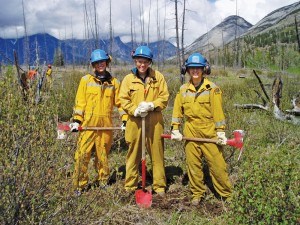Can you name that weed? This crew can!

Jasper National Park is thrilled to welcome this year’s Vegetation Restoration crew. With this enthusiastic group of 16 students, invasive plant species don’t stand a chance.
Fresh off their Parks Day education blitz—which featured a “live” display of native versus non-native plants and restoration themed face-painting—the crew is once again out planting and plucking in the park.
Invasive species are one of the major threats to our natural environment. The World Conservation Union has identified invasive species as the second most significant threat to biodiversity after habitat loss. They degrade natural environments by competing with native vegetation, and they affect the wildlife of invaded ecosystems by altering their habitat and foraging opportunities.
Jasper’s Vegetation Restoration Program and crew have worked since 1990 to combat this issue.
This year, the crew includes university students from Dalhousie, Guelph, Victoria, and beyond, as well as four Jasper Senior High students. These valuable employees are part of the Federal Student Work Experience Program (FSWEP). Parks Canada benefits from their high energy, innovative ideas, and keenness to learn, while the students gain varied and meaningful work experience in this special, protected place.
Funding for vegetation restoration in Jasper National Park comes from a number of sources. The program would not be possible without this cooperation, from partners like the Municipality of Jasper, Jasper National Park, ATCO Pipelines, Parks Canada National Fire, as well as the Waste Water Treatment Plant.
2014 Projects
Here are just a few of the on-going projects keeping the crew busy this summer:
- Whistlers Campground tree planting;
- Whistlers Summit trail delineation and re-vegetation;
- Planting vegetation barriers, and installing signage on trails being rehabilitated to help protect wildlife corridors;
- Removing non-native vegetation from key locations.
Parks Canada
Special to the Fitzhugh
